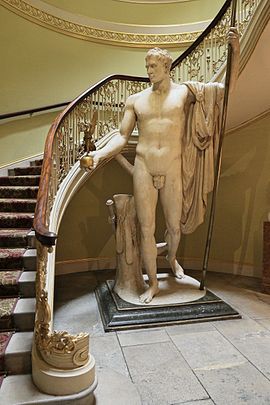Napoleon as Mars the Peacemaker
| Napoleon as Mars the Peacemaker | |
|---|---|
 | |
| Artist | Antonio Canova |
| Year | 1802-1806 |
| Medium | white marble gildedbronze |
| Dimensions | 345 cm (136 in) |
| Location | Apsley House,London |
Napoleon as Mars the Peacemakeris a colossalheroic nudestatue by the Italian artistAntonio Canova,ofNapoleon I of Francein the guise of the Roman godMars.He holds a gildedNikeorVictorystanding on anorbin his right hand and a staff in his left. It was produced between 1802 and 1806 and stands 3.45 metres to the raised left hand. Once on display in theLouvrein Paris, it was purchased fromLouis XVIIIin 1816 by the British government, which granted it to theDuke of Wellington.It is now on display inRobert Adam's stairwell at the Duke's London residence,Apsley House.

History[edit]
At Napoleon's personal and insistent demand, Canova went to Paris in 1802 to model a bust of him. In 1803, after his return to Rome, he began work on the full-length sculpture; it was completed in 1806.[1]: 93 Its idealised nude physique draws on the iconography ofAugustus,and it was always intended for an interior entrance-hall setting rather than as a freestanding piazza sculpture, though some accounts give the centre of the courtyard of the Palazzo del Senato as the original intended site for the sculpture, following plans drawn up by the architectLuigi Canonica.France's ambassador in RomeFrançois Cacaultand the director of French museumsVivant Denonboth saw the sculpture while it was a work in progress: Cacault wrote in 1803 that it "must become the most perfect work of this century", whilst Denon wrote back to Napoleon in 1806 that it belonged indoors in theMusée Napoléon"among the emperors and in the niche where theLaocoonis, in such a manner that it would be the first object that one sees on entering ". In late 1810 the sculpture was transported to France, reaching Paris on 1 January 1811.[1]: 100 When Napoleon saw it there in April 1811 he refused to accept it, calling it "too athletic" and banning the public from seeing it.
By 1814, the sculpture was in theSalle des Hommes Illustres,hidden behind a canvas screen, where it was probably first seen by Wellington. In the era after thebattle of Waterloo,Canova, who was still regarded as the best living artist, with his works in great demand from English patrons in particular, supported the return of looted sculptures from the Musée Napoléon to their original collections. The Musée Napoléon reverted to being the Louvre and its looted sculptures such as theApollo Belvederewere returned to their original collections. The removal of theNapoleonwas also mooted, and Canova offered to re-purchase it. It was sold to the British government in 1816 for 66,000 francs (then under £3,000), which the Louvre spent on re-installing its Salle des Antiques. Works by Canova were already being collected by the Duke, and thePrince Regentpresented it to him later that year. It was moved to the stairwell in Apsley House in 1817, where the floor under the statue was specially strengthened in order to accommodate the additional weight. It is still on display there.
Bronze in Milan[edit]
In 1811 abronze copy of the statuewas cast in Rome by Francesco Righetti and his son Luigi,[2]: 266 [3]: 200 using the bronze of the cannons ofCastel Sant'Angeloin Rome.[4]A previous attempt to cast the statue had failed.[4]Since 1859 the bronze has stood in the main courtyard ofPalazzo Brera,home of theAccademia di Belle Arti di Breraand thePinacoteca di Brera,inMilan,inLombardyin northern Italy.[5]: 252 It was at first on a temporary base; this was replaced in 1864 with the present base designed byLuigi Bisi,ingraniteandCarrara marble,with bronze decorations.[4]The gilded bronzewinged victoryon the globe in the right hand of the figure was stolen on 25 October 1978;[citation needed]it was replaced with areplicain the 1980s.[4]
Plaster casts[edit]
In spite of the poor reception of the marble statue, Canova had itcast in plaster.Five copies were made, and were destined for theAccademie di Belle Artiof Italy. The best-preserved of these is now, followingrestorationinFlorence,in the Pinacoteca di Brera.[6]It was initially sent, divided into eight sections, toPadova;however, it was not paid for and stayed in its packing-cases. It was bought by Napoleon's step-son, theviceroyEugène de Beauharnais,and was on display in the Galleria Reale in Palazzo Brera from 1809 to 1814. After the fall of Napoleon it was relegated to the storerooms of the Accademia, where it remained until 2008. It was restored, and installed in the Pinacoteca di Brera in 2009 for the bicentenary of the gallery.[4][6]
References[edit]
- ^abChristopher M.S. Johns (1998).Antonio Canova and the Politics of Patronage in Revolutionary and Napoleonic Europe.University of California Press.ISBN9780520212015.
- ^Maria Giulia Marziliano (ed.) (2003).Architettura e urbanistica in età neoclassica: Giovanni Antonio Antolini (1753– 1841): atti del I. convegno di studi antoliniani (nel secondo centenario del progetto per il Foro Bonaparte, Bologna, 25 settembre 2000 – Faenza, 26 settembre 2000)(in Italian). Faenza: Gruppo editoriale Faenza editrice.ISBN9788881380435.
- ^Rossella Leone (ed.) (2002).Il Museo di Roma racconta la città(exhibition catalogue, in Italian). Rome: Gangemi.ISBN9788849202748.
- ^abcdeFrancesco Berlucchi (26 October 2013).L'incredibile storia della statua di Napoleone a BreraArchived4 March 2016 at theWayback Machine(in Italian).La Stampa,Milan: "Voci di Milano". Accessed September 2015.
- ^Giovanna Cassese (2013).Accademie: Patrimoni di Belle Arti(in Italian). Rome: Gangemi Editore.ISBN9788849276718.
- ^abMichele Tavola (28 April 2009).Torna il Napoleone del Canova: dopo il restyling è come nuovo(in Italian).La Repubblica,Milan. Accessed September 2015.
Further reading[edit]
- Sewell, Brian(14 December 2007)."Seven wonders of London".Evening Standard.
- Christopher M. S. Johns, 'Portrait Mythology: Antonio Canova's Portraits of the Bonapartes',Eighteenth-Century Studies,Vol. 28, No. 1 (Autumn, 1994), pp. 115–129 (available onJSTOR2739227)
- Sculptures by Antonio Canova
- Sculptures of Napoleon
- 1806 sculptures
- Marble sculptures in the United Kingdom
- Bronze sculptures in Italy
- Statues in Italy
- Nude sculptures in the United Kingdom
- Sculptures of Roman gods
- Wellington Collection
- Mars (mythology) in art
- Statues in the City of Westminster
- Louis XVIII
- Arthur Wellesley, 1st Duke of Wellington

